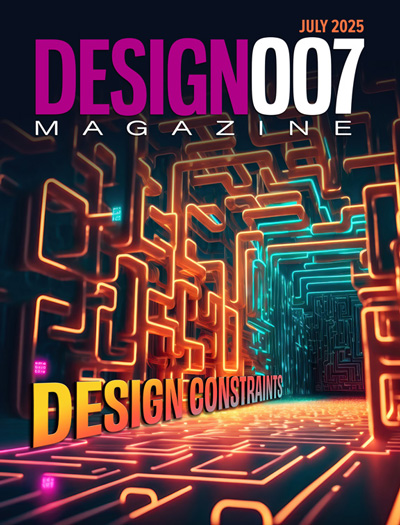-

- News
- Books
Featured Books
- design007 Magazine
Latest Issues
Current Issue
Signal Integrity
If you don’t have signal integrity problems now, you will eventually. This month, our expert contributors share a variety of SI techniques that can help designers avoid ground bounce, crosstalk, parasitic issues, and much more.

Proper Floor Planning
Floor planning decisions can make or break performance, manufacturability, and timelines. This month’s contributors weigh in with their best practices for proper floor planning and specific strategies to get it right.

Showing Some Constraint
A strong design constraint strategy carefully balances a wide range of electrical and manufacturing trade-offs. This month, we explore the key requirements, common challenges, and best practices behind building an effective constraint strategy.
- Articles
- Columns
- Links
- Media kit
||| MENU - design007 Magazine
Tiny Electric Generators Could Accelerate Wound Healing
January 19, 2022 | ACN NewswireEstimated reading time: 2 minutes
Tiny dressings that generate electricity in response to movement could accelerate wound healing and tissue regeneration. Scientists in Taiwan reviewed the latest advances and potential applications of wound healing technology in the journal Science and Technology of Advanced Materials.
The natural wound healing process involves complex interactions between ions, cells, blood vessels, genes and the immune system; with every player triggered by a sequence of molecular events. An integral part of this process involves the generation of a weak electric field by the damaged epithelium - the layer of cells covering tissue. The electric field forms as a result of an ion gradient in the wound bed, which plays an important role in directing cell migration and promoting blood vessel formation in the area.
Scientists discovered in the mid- to late-1900s that stimulating tissue with an electric field could improve wound healing. Current research in this field is now focused on developing small, wearable, and inexpensive patches that aren't encumbered by external electrical equipment.
This has led to research on piezoelectric materials, including natural materials like crystals, silk, wood, bone, hair and rubber, and synthetic materials such as quartz analogs, ceramics and polymers. These materials generate an electric current when exposed to mechanical stress. Nanogenerators developed using the synthetic materials are especially promising.
For example, some research teams are exploring the use of self-powered piezoelectric nanogenerators made with zinc oxide nanorods on a polydimethylsiloxane matrix for accelerating wound healing. Zinc oxide has the advantage of being piezoelectric and biocompatible. Other scientists are using scaffolds made from polyurethane and polyvinylidene fluoride (PVDF) due to their high piezoelectricity, chemical stability, ease of manufacturing and biocompatibility. These and other piezoelectric nanogenerators have shown promising results in laboratory and animal studies.
Another type of device, called a triboelectric nanogenerator (TENG), produces an electric current when two interfacing materials come into and out of contact with each other. Scientists have experimented with TENGs that generate electricity from breathing movements, for example, to accelerate wound healing in rats. They have also loaded TENG patches with antibiotics to facilitate wound healing by also treating localized infection.
"Piezoelectric and triboelectric nanogenerators are excellent candidates for self-assisted wound healing due to their light weight, flexibility, elasticity and biocompatibility," says bioengineer Zong-Hong Lin of the National Tsing Hua University in Taiwan. "But there are still several bottlenecks to their clinical application."
For example, they still need to be customized so they are fit-for-size, as wound dimensions vary widely. They also need to be firmly attached without being negatively affected or corroded by the fluids that naturally exude from wounds.
"Our future aim is to develop cost-effective and highly efficient wound dressing systems for practical clinical applications," says Lin.
Testimonial
"The I-Connect007 team is outstanding—kind, responsive, and a true marketing partner. Their design team created fresh, eye-catching ads, and their editorial support polished our content to let our brand shine. Thank you all! "
Sweeney Ng - CEE PCBSuggested Items
Curing and Verification in PCB Shadow Areas
09/17/2025 | Doug Katze, DymaxDesign engineers know a simple truth that often complicates electronics manufacturing: Light doesn’t go around corners. In densely populated PCBs, adhesives and coatings often fail to fully cure in shadowed regions created by tall ICs, connectors, relays, and tight housings.
Marcy’s Musings: Advancing the Advanced Materials Discussion
09/17/2025 | Marcy LaRont -- Column: Marcy's MusingsAs the industry’s most trusted global source of original content about the electronics supply chain, we continually ask you about your concerns, what you care about, and what you most want to learn about. Your responses are insightful and valuable. Thank you for caring enough to provide useful feedback and engage in dialogue.
September 2025 PCB007 Magazine: The Future of Advanced Materials
09/16/2025 | I-Connect007 Editorial TeamMoore’s Law is no more, and the advanced material solutions being developed to grapple with this reality are surprising, stunning, and perhaps a bit daunting. Buckle up for a dive into advanced materials and a glimpse into the next chapters of electronics manufacturing.
I-Connect007 Launches Advanced Electronics Packaging Digest
09/15/2025 | I-Connect007I-Connect007 is pleased to announce the launch of Advanced Electronics Packaging Digest (AEPD), a new monthly digital newsletter dedicated to one of the most critical and rapidly evolving areas of electronics manufacturing: advanced packaging at the interconnect level.
Panasonic Industry will Double the Production Capacity of MEGTRON Multi-layer Circuit Board Materials Over the Next Five Years
09/15/2025 | Panasonic Industry Co., Ltd.Panasonic Industry Co., Ltd., a Panasonic Group company, announced plans for a major expansion of its global production capacity for MEGTRON multi-layer circuit board materials today. The company plans to double its production over the next five years to meet growing demand in the AI server and ICT infrastructure markets.


